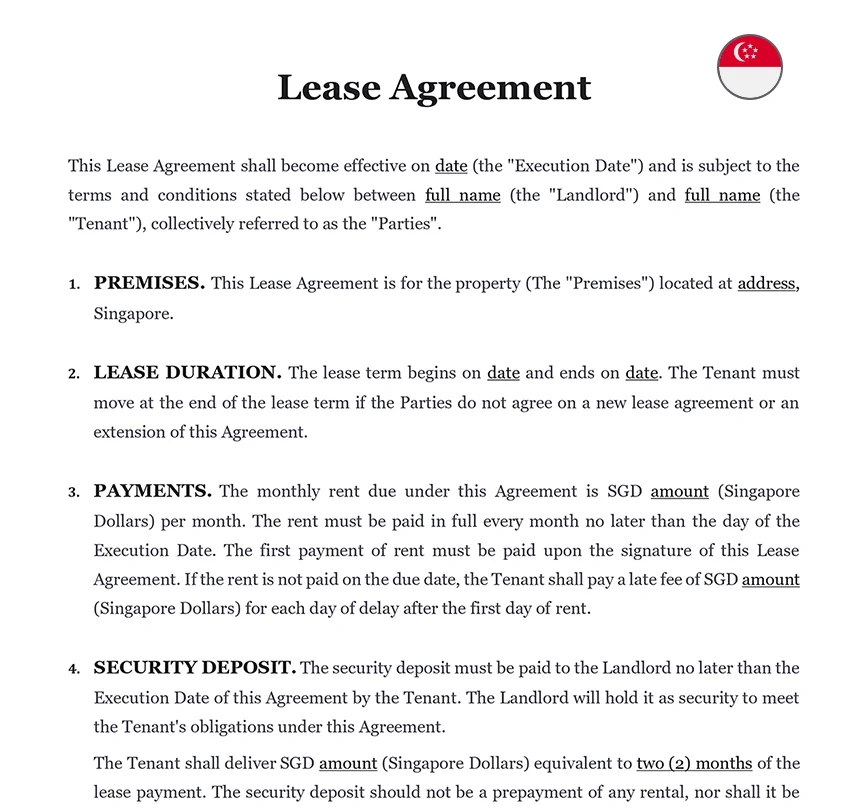We know that’s a rather long list, but don’t feel stumped. Below, we’ve gone on to narrow down the lease agreement clauses you should pay more attention to.
Before we begin, it’s important to note that signing a lease agreement without understanding the clauses in one can put you in an unfavourable position. When in doubt on any terms in the agreement, you should clarify them with your property agent or landlord.
If you’re told to ignore anything, don’t–it could put you in a worse situation later. For example, you might find yourself in a dispute with your landlord due to misunderstandings on the rental conditions.
If you are an expatriate, make sure this clause is included in the lease agreement. Although it’s usually included in the standard template, it’s good to double-check.
Typically taking effect from the midway point in the clause (e.g. after the first year of a two year lease), this clause allows you to break the lease agreement under certain conditions. In the event that you are unexpectedly posted to another country and need to leave Singapore, you can invoke the diplomatic clause to terminate the lease agreement without incurring a heavy penalty.
Note that the diplomatic clause notice period is usually 2 months. After all, your landlord needs sufficient time to find another tenant to replace you.
You’ll need to pay the security deposit when you sign the lease agreement, and this is usually 1 month’s rent for a 1-year lease. If you’ve already paid a good faith deposit after signing a Letter of Intent (LOI), the landlord or his/her agent may agree to ‘convert’ the balance of the good faith deposit into the security deposit, for simplicity’s sake.
At the end of the lease, deductions are usually made from the security deposit for property damaged during the tenant’s stay. Note that the deposit may not be used to offset rent during the lease.
The clause for security deposit usually sets the terms for a deduction, which is used to cover the cost of repairing and replacing the damaged items, while allowing leeway in fair wear and tear of items over time.
Case in point: A slightly faded curtain is usually considered fair wear and tear damage and should not entitle the landlord to deduct from the security deposit. On the other hand, if the tenant breaks something that will not be damaged under normal circumstances (for example shattering an expensive ceiling light or cracking the bathtub), the landlord may justifiably deduct your security deposit to fix or replace the damaged items.
Do make sure the clause clearly states a firm deadline for when the security deposit will be refunded. In general, your security deposit should be returned to you upon the return of keys at the end of the tenancy.
Sometimes, however, it’s not unusual for the agreement to specify a 7 to 30-day waiting period after the end of the tenancy before the return of the Security Deposit. This period is for the landlord to accurately assess the cost of any repairs that may be needed.
For clauses that involve repair and maintenance, check the amount that you are liable for. As a tenant, you’re required to pay for minor repairs caused by wear and tear. This helps to ensure that you strive to keep the property in good condition.
A standard lease agreement usually states that tenants are liable to pay for any repair and maintenance costs that fall below a certain amount. This amount can range from $150 to $300 and could be for things such as air-conditioning servicing, tap repairs, and new light bulbs.
Should the cost of repairing an item exceed the amount that you’re liable for, the landlord is obliged to cover the remaining cost.
For instance, let’s say the clause states that you’re liable to pay for up to $150. If an air-con needs to be repaired and costs $200, you’ll have to pay $150 for it. The remaining $50 will then be covered by your landlord.
Note that the clause should also include the grace period for reporting defects, which is usually the first 30 days of the lease period. These defects may include faulty plumbing or electrical wiring, malfunctioning air-conditioning, or broken sockets.
During this grace period, you can inform your agent or ask your landlord to get them repaired without having to pay out of your own pocket. Do remember to take photos of these faults and send them to your agent or landlord within this period, through a time-stamped email.
Just to be sure, the lease agreement should state clearly that the landlord will be responsible for resolving these defects if reported within the grace period. This ensures that you will not have to pay for damages caused by a previous tenant.
This clause basically lists down all the items in the room or property, such as appliances and furniture.
Before you sign on the dotted line, check that all the items listed in the inventory match with the ones available in the property you’re renting. Be extra meticulous when you check this section and ensure that all the items are as described and are in working order. If there are any items that are faulty, be sure to inform your landlord about them so he or she can get them replaced.
This is also the chance for you to request the landlord to remove any items in the property. If there’s a particularly expensive item, you may request for its removal from the inventory so you won’t run the risk of breaking or damaging it.
It also doesn’t hurt to note down the brands and even the model numbers of the inventory items. We’ve heard of dishonest landlords who use the inventory list to cheat tenants.
Noting down the details will prevent any unscrupulous landlords from accusing you of swapping an appliance for a cheaper model, insisting that you pay for the original.
Most of us probably wouldn’t be too comfortable having a friend, or even a family member, popping by our home unannounced. What more a landlord?
In a nutshell, the privacy and access clause protects your privacy. Under this clause, your landlord is required to get your permission before coming to the property.
In addition, the clause specifies a list of reasons under which the landlord is allowed to access the premises while you’re staying there. This usually includes the following:
Note that the clause should state how early the landlord should notify you in advance before dropping by. This ensures that your landlord does not show up at the place at the last minute.




